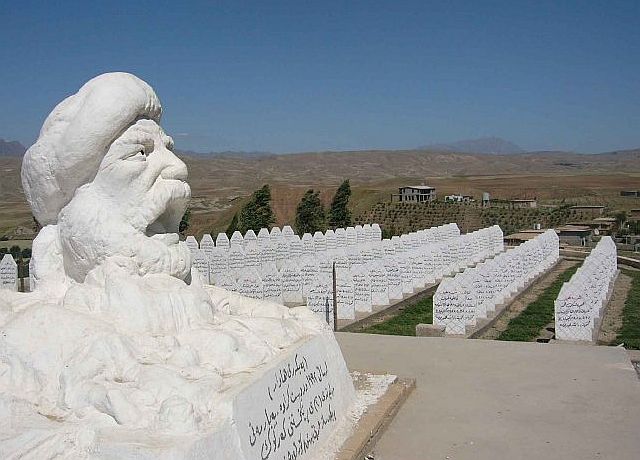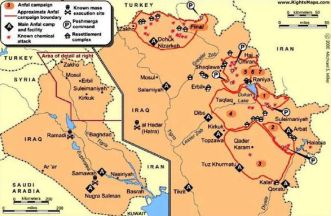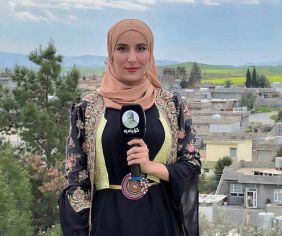Like many villages, Goptapa was attacked with poison gas by Saddam’s troops in 1988 and then completely destroyed. The consequences are still felt today, but the residents who have returned are not only dealing with the past, they are also working towards a better future. Wadi is there to help with both.
A report by Richard Wilde, April 2024

Memorial in Goptapa, Picture Hemn Goptapy
Goptapa is a small village between Kirkuk and Erbil in the Kurdistan Autonomous Region of Iraq. Located on the Zab river, over 400 families live here. There are schools, a library, several shops and a shockingly large cemetery, reminding you that many people died a gruesome death here. A large statue sits in the middle of the cemetery. You can see a screaming face surrounded by dead bodies. The statue is called “The Scream”, in reference to the famous painting by Edvard Munch. The monument is intended to commemorate the horrors that Goptapa and other villages in the region endured in the late 1980s.
At that time, towards the end of the Iran-Iraq War, Iraq’s dictator, Saddam Hussein, fought not only against Iran, but also against the Kurdish population and Peshmerga (armed liberation fighters) in northern Iraq. Poison gas (banned internationally after WWI) was deliberately used. The largest of these attacks with the most casualties took place in Halabja and the pictures went around the world at the time. Halabja also became a symbol of the brutality of the Saddam regime.

Somewhat forgotten is the fact that dozens more poison gas attacks occurred the same year as part of the Anfal campaign, with the goal to completely destroy Kurdish infrastructure.
The Anfal campaign was divided into eight phases and lasted from February to October 1988. Each of these phases targeted a different area. In the fourth phase, the Zab River valley was targeted. The exact procedure in the individual villages varied, but it roughly followed this pattern: first an attack from the air – in some cases with poison gas – then the ground troops came. Women and children were separated from men and taken to camps in southern and central Iraq. Many of the men were sent to prison camps or were executed on the spot.
To this day, there is no trace of over one hundred thousand people who fell victim to this campaign. Countless human remains have been recovered in multiple mass graves, after the fall of Saddam in 2003.
In Goptapa it was May 3, 1988, when the Iraqi Air Force attacked. This had happened before, but on that day the planes dropped poison gas. This marked the beginning of the fourth phase of the Anfal operation. Shortly thereafter, ground forces launched an offensive from all four sides. There were a number of Peshmerga living in the village who played a particularly important role in the Kurdish resistance against the Saddam regime, which is probably why the attack was particularly severe. At least that’s what Hawraz Rafiq, survivor and son of the region’s Peshmerga commander, thinks.
Those who survived the initial air and land attacks, tried to escape into a cave below the village, but they were soon surrounded. The people of the village resisted in a three-hour firefight until the Iraqi army completely took over the village. This is how Hawraz, who was 14 years old at the time, tells it. The women and children were deported while the men were taken to special prison camps in the south of Iraq. To this day, we still don’t know what happened to most of them, but there is little to suggest that they remained alive.
Return after the liberation of Kurdistan
After the Kurdish mass uprisings – spring 1991- large parts of the Kurdish areas were liberated. Little by little, people returned to their villages. So too after Goptapa. Hawraz talks about the completely destroyed village they found back then. Not only almost all the houses, but also all the trees and fields were destroyed. Those who returned rebuilt the village and the houses as well as they could have under the difficult conditions of the early 1990s. As they cleared the rubble, they found more and more remains of their relatives and fellow villagers. In order to give them their final resting place, the cemetery with the ‘screaming monument’ was built.
In addition to Hawraz, Hemn Goptapy also came back to his home village. For him and others, it was not only important to remember the terrible past, but also to find ways to work together to ensure a better future. And this approach has worked so well in Goptapa that the local media is now referring to the village as a role model: with over 400 families, there are now even more people than before the Anfal campaign. Other villages in the region, however, have not been so lucky and are suffering from an exodus never able to recover from the disaster.
However, more and more people who had found refuge in the cities are now moving back to Goptapa. The schools and the library were built together with the local village committee of volunteers. But that’s not all they do, the village committee of volunteers also takes care of environmental protection: you can now see trees and green areas everywhere in Goptapa. “A sign of resistance,” says Hemn, “we show that Saddam has not triumphed over us.”
He has also been collecting old photos and stories for years from the surrounding areas. He often comes across photos of other families. He then hands these over to their relatives, if he can find them. He is convinced that this is an important way to come to terms with the past. He even wants to use the collected materials to build a small museum, not only for the local population but also for visitors from other parts of Iraq and abroad. According to his own statements, he had already collected photos and stories from over three quarters of all people living in the region during the fourth phase of the Anfal operation. The goal is of course also to collect information in the other areas. But not only that, but also to carry the power of reconstruction and new beginnings from Goptapa to the other villages.
A Community organizes itself
For many years, Wadi has been supporting the efforts in Goptapa, whenever new activities arise. A group of lifeguards was recently formed because Goptapa is a popular excursion destination, especially in summer, but sadly people kept drowning in the river. These lifeguards now provide their services for the visitors and locals. A women’s group has also been founded that is not only committed to equal rights, but also promotes projects that aim to increase women’s economic independence

We should also not forget the football team, for which Wadi provided all the kits and balls (we are quite happy to see our logo on them). And to make all of this better known regionally, Goptapa now has his own media channel on Facebook and Twitter Citizen-Journalists, who received training from our partner organization Kirkuk-Now, report on activities, problems in the region and simply what happens every day.
Some of these projects are now also supported by Kurdish regional politicians who have been impressed by this self-organized approach, which is particularly important in order to become independent from international aid in the long term.
An example of civic engagement
Goptapa has become an example of what a civil society based approach that Wadi supports can achieve. In Goptapa, a previously neglected place in the Kurdish province, the residents did not wait for help to come from outside at some point, but rather took their fate into their own hands.
What is really special is the close connection between dealing with one’s own past under the Iraqi regime and the desire to create a better and self-determined future for oneself and the next generations.
The people in Goptapa also have an important message: Even though they, their parents and grandparents have experienced indescribable horrors and countless people have died, they do not want to be seen only as victims. Quite the opposite: What happened to them before should never happen again. And if they had to experience so much violence, today they want no violence to be used in schools, families or even against nature. This is also why Goptapa was part of Wadi’s ‘No to Violence’ Campaign from day one. And they are proud that what used to happen to almost every child (corporal punishment) is now history.
International cooperation
How do you remember? What ways and means are there to do this? Residents have been asking this question again and again because there are few good examples in the region. There are many concrete monuments in the area that the survivors can hardly identify with. That’s why Wadi is also in dialogue with those who want to create different museums, one that belongs to the people and is designed by them. Hemn is collecting ideas for this, and if everything goes well, he will come to Germany in the summer at the invitation of the Rosa Luxemburg Foundation and Wadi to visit Bergen-Belsen and exchange ideas with experts at memorial sites
Video: An example for Citizens Journalism, A report done by Goptapa TV











